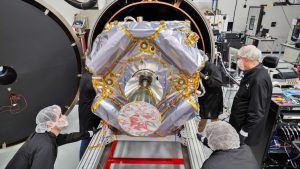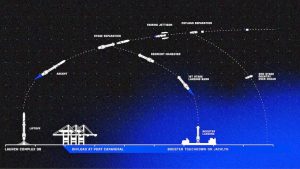Blue Origin Successfully Launches ESCAPADE Mars Mission, Lands Rocket
Blue Origin has successfully launched its ESCAPADE mission to Mars from Cape Canaveral Space Force Station, achieving a major milestone for private spaceflight and NASA’s scientific exploration. The rocket’s first stage autonomously landed on the droneship Jacklyn in the Atlantic Ocean, demonstrating Blue Origin’s reusability strategy.
Key Takeaways
- ESCAPADE Mars mission launched successfully with rocket landing
- Mission utilizes twin spacecraft to study solar wind effects on Mars
- Expected to reach Mars orbit in 2027 after 22-month journey
- Second flight of Blue Origin’s New Glenn heavy-lift rocket
Mission Details and Launch
The launch occurred during a window that opened at 1:27 am IST and extended until approximately 2:55 am IST. Blue Origin utilized its New Glenn rocket, a 321-foot-tall two-stage heavy-lift vehicle designed for orbital and interplanetary missions. This marks only the second flight of New Glenn since its inaugural launch earlier this year.

What is the ESCAPADE Mars Mission?
ESCAPADE, which stands for Escape and Plasma Acceleration and Dynamics Explorers, consists of two twin spacecraft named Blue and Gold. These spacecraft were built by Rocket Lab under NASA’s SIMPLEx program and will travel to Mars to study the interaction between solar wind and the Martian magnetic field.
Understanding how solar wind strips Mars of its atmosphere is considered critical for both planetary science and future human exploration efforts.
Mission Timeline and Objectives
After deployment from New Glenn’s second stage, the ESCAPADE spacecraft will first orbit near the Earth-Sun Lagrange Point 2 before beginning their interplanetary journey to Mars. The mission duration is expected to last over 22 months, culminating in orbit insertion around Mars, followed by a detailed study phase.

Overcoming Launch Challenges
The launch had been previously postponed due to weather concerns and intense solar activity that could have threatened spacecraft safety. With improved space weather conditions now predicted, NASA and Blue Origin proceeded with the successful launch.
Scientific Significance
If successful, ESCAPADE will significantly enhance understanding of space weather dynamics and their effects not just on Mars but also on Earth and other planets. The mission represents a convergence of commercial launch capability and cutting-edge space science, reflecting the evolving landscape of planetary exploration.
With New Glenn’s proven heavy-lift capability and Blue Origin’s ambitious plans for lunar and deep space missions, this launch marks an important chapter in Mars exploration and commercial spaceflight.






